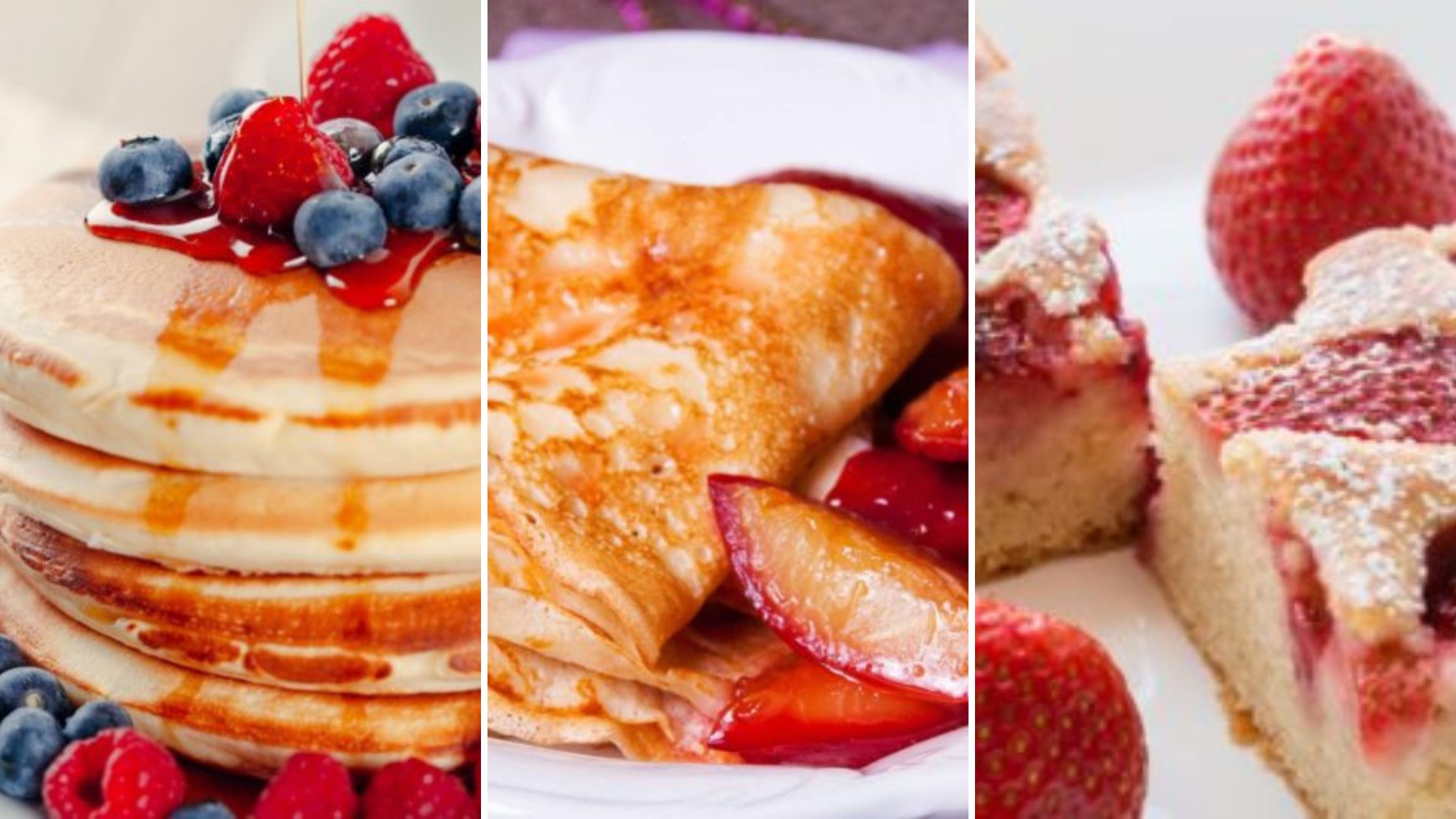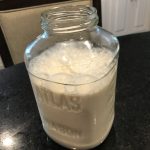There’s nothing quite like pancakes. Just about every culture I can think of has some sort of a recipe for them. And many people enjoy them, not just for breakfast, but sometimes even dinner. This can sometimes be a challenge for those who are dealing with gluten-sensitivity issues.
Whether it’s full-on celiac disease, an allergy to one or more grains, or digestive issues that simply don’t agree with consuming grain products, it can be somewhat difficult when you want to enjoy a pancake.
-
Gluten-Free Berry Cheese Pancakes
This is a wonderful alternative to traditional pancakes. High in protein and very delicious, it’s easy to make, and you won’t miss the flour. Obviously, if you’re sensitive to dairy you’ll need to substitute your favorite non-dairy cream cheese instead.

Gluten Free Berry Cheese Pancakes
Ingredients
- 8 ounces cream cheese, brought to room temperature and cut into cubes
- 6 large eggs
- ½ teaspoon ground cinnamon
- 1 teaspoon vanilla extract
- 3 tablespoons organic butter, divided
- 1 cup fresh blueberries
- 1 strawberries fresh strawberries, sliced
- Maple syrup, optional
Instructions
- Add cream cheese, eggs, cinnamon, and vanilla extract to a food processor or blender
- Blend on high until completely smooth
- Heat a large pan (or griddle) to medium heat
- When hot add ½ tablespoon butter to the pan, spreading to cover
- Pour small pancakes onto the pan (approximately 3) — leave space in between so they don’t run together
- Cook until the edges just begin to turn brown and the pancakes are set, about 3 minutes.
- Carefully flip each pancake and continue cooking for another 1-2 minutes until bottom is golden brown on the bottom
- Transfer cooked pancakes wire rack and keep warm (I like to use my microwave oven for this. It’s over the cooktop and it’s an insulated box. Don’t put pancakes on a plate as the bottom ones get soggy if you do)
- Repeat until all the pancakes are made
- Serve pancakes topped with berries and maple syrup, if usingEnjoy!
2. Banana Oat Pancakes
This recipe is simple and delicious. One of the things that my family likes so much about it is that the pancakes are very fluffy. You don't realize that these are whole-grain oat pancakes they are that light and airy. The bananas combined with the cinnamon and nutmeg make it a delicious way to start your day. I also like having another great recipe that allows me to use up any almost over-ripe bananas.

King Arthur Flour's Banana-Oat Pancakes
Ingredients
- 3 small bananas mashed
- 2 T. unsalted butter melted (use organic)
- 1 T. lemon juice
- 1 T. sugar (I reduce this to 1 t. as the bananas when they are this ripe have a lot of natural sugars)
- 2 eggs
- 1 C. oat flour
- 1/2 t. baking soda
- 1/2 t. salt
- 1/2 t. ground cinnamon
- 1/2 t. ground nutmeg
Instructions
- Stir together the mashed bananas, butter, lemon juice and sugar in a medium bowl.
- Beat in the eggs.
- Whisk together the oat flour, baking soda, salt and spices in a small bowl.
- Form a well in the center of the dry ingredients and pour in the wet ingredients.
- Stir the batter just until the dry ingredients are thoroughly moistened.
- Check to be sure the batter is thin enough for your pancakes; you may need to add a touch of milk or water (I never do)
- Let the batter sit 10 minutes before using.
- Heat a nonstick griddle or heavy skillet.
- If your surface is not non-stick brush it lightly with vegetable oil.
- When the surface is ready spoon batter 1/4 C. at a time into the pan.
- Let the pancakes cook on the first side until bubbles begin to for around the edges, 3-4 minutes.
- When the pancakes are just beginning to set flip then and let them cook on the second side, about 1 1/2 minutes more.
- You can sprinkle toasted walnuts over the batter just before cooking as an extra treat.
3. Ricotta Pancakes with Honey-Glazed Plums
The inspiration for this was a click-through Twitter post that brought me to Almost Bourdain's (AB's) blog, which I recently discovered and like. He credits his inspiration for this recipe to Bill Granger, I credit my inspiration to him. It's kind of neat how that works, we're all connected by this idea of ricotta in pancakes, but we each put a slightly different twist to it; all of them, I'm sure, are very delicious.

Ricotta Pancakes with Honey Glazed Plums
Ingredients
- For the pancakes:
1 1/3 C. ricotta cheese
3/4 C. buttermilk (for a little tang to offset the honey glazed plums)
4 eggs separated
1/2 C. fresh ground oat flour
1/2 C. fresh ground brown rice flour
1 t. baking powder
1 t. vanilla
pinch salt
- For honey-glazed plums:
2 plums
2 T. honey
1/2 t. cinnamon
2 t. butter
Instructions
- Pancake instructions:Beat egg whites until peaks form, set asideMix ricotta, egg yolks, vanilla, and buttermilk together until well blendedMix together flours, baking powder and saltGently add flours into ricotta mixtureGently fold egg whites into mixture until just blendedGrop by 1/4 C. measure into medium hot, greased panAfter 2 minutes flip to cook other side
- Instructions for plums:Cut plums into bite sized piecesToss with honey and cinnamonIn a medium-hot pan melt butterAdd plum mixture and stir until plums begin to soften just a little (about 7 minutes)Serve pancakes with plums on top
4. Classic Pancakes
These pancakes are very fluffy, combining the oat flour and the buttermilk. The whole grains soften a bit by letting the batter rest for a few minutes and soaking up some of that buttermilk to help make the pancakes fluffy and delicious.
Tip: The batter for this recipe does tend to be somewhat thin. It’s best to make smaller pancakes so you can flip them easily. Or thin the batter out a tiny bit more with some coconut milk and make a crepe-style pancake instead. so you may find smaller pancakes easier to flip.

Buttermilk Oat Pancakes
Ingredients
- 1/2 C. oat flour
- 1/2 C. brown rice flour
- 1 egg
- 1 1/2 T. melted coconut oil
- 1/2 t. baking powder
- 1/2 t. baking soda
- 1 t. vanilla
- 1 T. sucanat
Instructions
- Mix the dry ingredients together
- Beat the egg
- Add beaten egg and other liquid ingredients to the dry mixture
- Let mixture sit for 5 minutes
- Cook in pan lightly greased with coconut oilEnjoy!
5. Strawberry Sheet Pan Cakes
Hosting a brunch or feeding a crowd? These strawberry sheet pan cakes are the perfect solution. Baked to golden perfection in a sheet pan and topped with fresh strawberries, these pancakes are as convenient as they are delicious. Get the recipe here: Strawberry Sheet Pan Cakes.


























